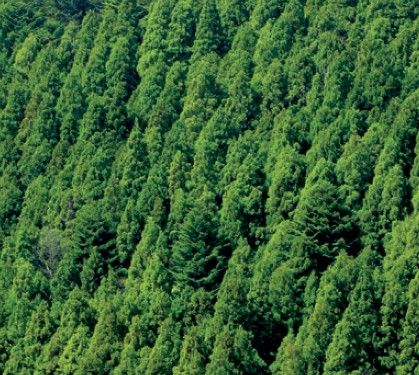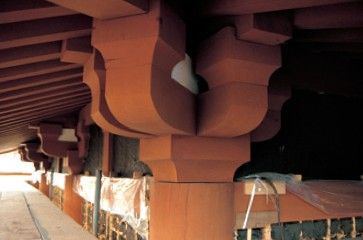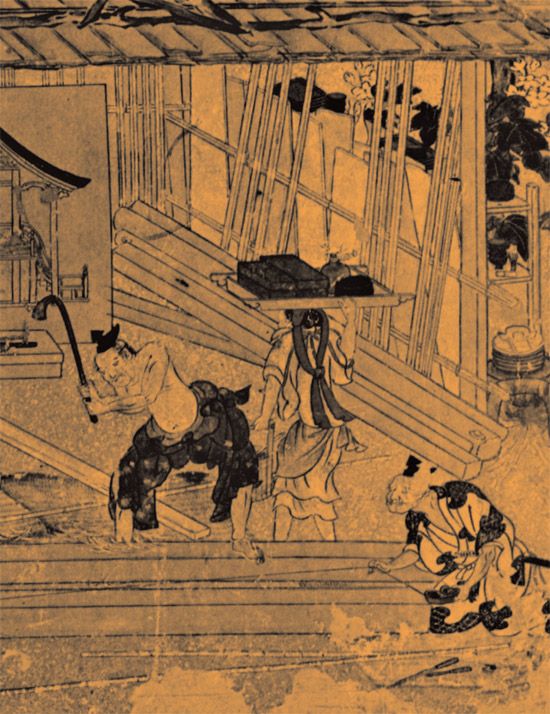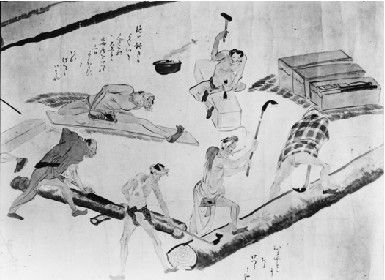CHAPTER 1
WOODWORKING
IN JAPAN
In most discussions of traditional Japanese architecture, one of the first questions raised is why wood has been the primary building material, contrasting so sharply with the Western tradition, whose ancient monuments were almost always of stone and brick, and even with Chinese and Korean architecture, where masonry figures almost as prominently as wood. The Japanese invariably attribute their universal use of wood to the archipelago’s natural endowments. Wood and bamboo have existed in abundance from primeval times, while accessible and appropriate building stone was negligible. Seismic disturbances are also frequent. Hence, the reasoning follows, practical limitations dictated an exclusively wooden architecture.
We need not, perhaps, accept this explanation at face value. After all, Japan is a mountainous country with an abundance of rock, and a glance at the stone walks of medieval gardens, or at the meticulous masonry of castle retaining walls, reveals a highly refined aesthetic sensitivity and technical sophistication. Why were these techniques not utilized in the construction of entire buildings?
Figure 13 Master carpenter at work, from Shokunin zukushi-e, ca. 1640.
It may be that the choice of materials was influenced, much more than is generally recognized, by the manner in which mainland technology was received in Japan. Although a handful of large indigenous wooden shrine buildings preceded the introduction of Buddhist temple construction in the sixth century, the new woodworking tools and techniques represented a great leap forward in technological complexity, sophistication, versatility, and durability. Building upon woodworking methods whose rudiments were already familiar to the Japanese—we know from archaeological finds that pre-Buddhist Japanese building was chiefly in wood with the notable exception of monumental tombs that exhibit a precise fitting of huge stones—the Japanese were able to leapfrog several centuries of technological evolution. An important point to keep in mind, however, is that this technology was quickly canonized as emblematic of the new political regime, which sponsored its development and the education of new generations of craftsmen. While there must have been ample opportunity to acquire advanced masonry techniques as well as wood, both during this early stage of Buddhist architecture and in later centuries, the bureaucratic and educational system may have resisted such a step as a costly extravagance or as a challenge to the status quo. It may be that with no clearly perceived need for a parallel stoneworking tradition, the material was relegated as a matter of course to secondary uses in podia, foundations, decorative lanterns, miniature pagodas, walkways, and, much later, castle walls. Another factor may have been the susceptibility of masonry to earthquake damage, though this would seem to be offset by its increased resistance to fire.
On the other hand, an element of consideration for the supernatural possibly influenced these choices. Part of the value system symbolized by Shintō beliefs stresses love of and respect for wood as a living organism. A form of animism, Shintō ascribes consciousness and personality to natural forces such as wind and rain, sun and moon, geological formations, and non-human living things. Certain mountains are held sacred, as are parts of forests and even particular trees. The presence and will of these deities, or kami, pervaded everything. Without the permission and assistance of the gods, rice will not grow, women will not conceive, and a building will not stand.
These beliefs are celebrated to this day in the form of Shintō ceremonies for planting, marriage, and construction, to name a few, and although a diminishing number of people observe the old rituals, natural phenomena are still accorded a measure of respect. The almost religious reverence for wood is, fortunately for us, among the many traditions that have stood the test of time. A tree, like other natural phenomena, is believed to possess a spirit, and a carpenter, when he cuts down a tree, incurs a moral debt. One of the themes that runs throughout Japanese culture is the belief that nature exacts from man a price for coexistence. A carpenter must put a tree to uses that assure its continued existence, preferably as a thing of beauty to be treasured for centuries. There is a prayer that Nishioka would recite before laying a saw to a standing tree. It goes in part, “I vow to commit no act that will extinguish the life of this tree.” Only by maintaining this pledge does the carpenter repay his debt to nature.
Figure 14 Carpenters shown at work in a picture scroll dated 1805. Tokyo National Museum.
The types of trees that provided the lumber for the ancient temples of Nara and Kyoto continue to preside over the most highly respected traditions of woodworking in Japan. Perhaps the king of them all is the hinoki, a species of cypress. It is not only strong and resistant to decay but is easily workable, and has a fine grain, delicate color, and pleasant aroma. Japan’s once-extensive hinoki forests have largely been cut down, the toll being especially heavy during the mid-twentieth century war effort. Today, it is among the most costly of woods. In fact, it was already becoming scarce centuries ago, forcing carpenters to use less desirable species. Keyaki, or zelkova, is much harder and more elastic as well as fairly durable. Because of its striking grain and color, it has traditionally been one of the preferred woods for cabinetmaking, but even though it is less easily workable and less durable than hinoki, carpenters have been using it for major construction for centuries. Similarly, akamatsu, sometimes called mematsu (female pine), is a red pine that is less desirable for carpenters than hinoki, but which saw increasing use as hinoki became less easily available. The trunks of this timber, though often twisted, can be used skillfully in roof beams thanks to special techniques that have been developed for layout and joinery. Like most pine, its high resin content acts as a preservative, making it suitable for door sills and the like.
Sugi, a variety of cedar, is soft, durable, decay resistant, and straight-grained. Employed in both structural and decorative elements, its reddish brown color appears to great advantage in sliding door panels and cabinetry. Tsuga, a variety of yellowish brown spruce, is straight, flexible, and dense-grained. It has become the most common building material for all types of wooden construction, which today means primarily houses (although imported Douglas fir may displace it from time to time).
Other woods for more specialized uses include kashi (Japanese oak). Relatively scarce, it is employed for cabinets and household implements. Momiji (one type of Japanese maple) is also used for decoration. Kiri (paulownia) is extremely attractive and strong, but unfortunately rare. Although sometimes used in building, it is more commonly found in cabinetry and is the preferred wood for the small boxes in which precious scrolls and pottery are stored. Kuwa (mulberry) is hard and dark red, and is found in door pulls, carvings, and the like. Kuromatsu (black pine) and asunaro (cypress) are inferior woods of occasional use. Sakura, the famed flowering cherry of Japan, is planted for its blossoms only; its fruit is inedible and the wood rarely used.
Japanese carpenters, or daiku, are considered members of a class of worker known as shokunin. Usually translated as “craftsman” or “artisan,” the word shokunin has a strong ethical and spiritual nuance in Japanese. The use of the term, like that of daiku, has evolved over the centuries, but the essential values the term implies persist. The shokunin, in addition to repaying a debt to nature incurred by his exploitation of the earth’s resources, must fulfill his obligation to society, primarily by doing whatever is required quickly, skillfully, and without waste. This ethical code and social consciousness is cultivated from the beginning of apprenticeship, which before the days of compulsory secondary education started as early as age nine or ten. When a carpenter does a poor job, for instance, it reflects both on the client and on the master; in most cases, he is not allowed to redo the work, for that would entail waste. Everyone must live with the result. According to the craftsman’s code, this rule is applied to every task in life, even the menial and seemingly insignificant. The carpenter trained according to this tradition will not scoffat the most rudimentary task, says Nishioka, but will do any job that calls for woodworking—even making wooden clogs—with care and precision.
One traditional ideal, then, has been the carpenter who can perform any stage of the woodworking process, from felling trees to finishing surfaces, but in actuality there were and are specialities. There are lumberjacks who fell the trees but who are usually concerned only with the main trunk, the direction of fall, and so on. After that, a trimmer takes over, removing branches and stripping the bark. Another worker prepares logs for transportation. Finally, there is the sawyer, who transforms logs into squared lumber.
Next come the builders, beginning with the carpenters, divided over the centuries into several categories usually represented by local guilds. The “house carpenter,” highly skilled in comparison to his present-day American or European counterpart, is known for his knowledge of wood and mastery of the complicated joints still in use. The master house carpenter designs the house itself (according to traditional formulae and rules of thumb) and supervises the fabrication of the components, the erection of the frame, the finishing of the interior, and so on to completion. The actual work of assembling the frame is sometimes carried out by a separate group of craftsmen, the “erectors,” who carry out a variety of tasks, including the erection of the scaffolding.
Teahouse carpenters, who work on a reduced scale, create small, finely crafted buildings for the performance of the tea ceremony, usually formulating the design in conjunction with a tea school master. Tea ceremony rules call for subtle, unobtrusive design and an extremely sensitive handling of proportion and detail, as well as studied simplicity. Teahouse carpenters enjoy great prestige.
Temple carpenters, such as the late Nishioka, because of the scale of their work and its sacred nature, perform the most demanding type of carpentry and are regarded with a reverence bordering on awe. Their work includes the design and layout of Buddhist temples and Shintō shrines (although an individual rarely specializes in both). The construction of palaces in ancient times, incidentally, was often on a par with temple building, and castle building was equally demanding, but the carpenters were segregated into separate guilds. Temple carpenters must be well versed in Buddhist theology and ritual, and are treated as members of the clergy on certain ceremonial occasions. At the time of the Picture Hall construction at Yakushiji, Nishioka estimated there were some fifty master temple carpenters working in Japan, though very few had the opportunity to work on major projects.
堂塔建立の用材は木を買わず山を買え
“Don’t buy lumber for building material, buy a whole mountain.”
The characteristics of wood, its “spirit,” Nishioka was taught, emerge from the characteristics of the ground in which it grows. In order to fully grasp the idiosyncrasies of the wood that will be used, a carpenter should examine it in relation to its environment on the mountainside. Only then will he be able to predict how it will change in the future. Trees are individuals, Nishioka pointed out, but they grow in communities, and both aspects affect their “personalities.”

東西南北はその方位のままに 木は生育の方位のまま使え
“In a building, use wood in the same north–south–east–west orientation it grew in originally.”
A tree develops a kind of “harmony” with the forces that act on it while it is growing, like sunlight, wind, and rain, all of which typically reach the tree from specific directions depending upon where it is growing. Because of this, and the fact that wood will move and change in response to these same forces when it is integrated into a building, Nishioka and his forebears believed it was important to use wood in the same orientation it had when it was growing in order to make its future changes more predictable. Therefore, wood that grew on a northern slope should be used on the north side of the building, that from the southern slope on the south side, etc. Nishioka associated these principles with rules for selecting wood for specific uses depending on how high on the slope it grows as well; wood from trees growing midway up a mountain-side or in mountain passes will make the best structural timber, while wood from valleys is more appropriate for finish work.


